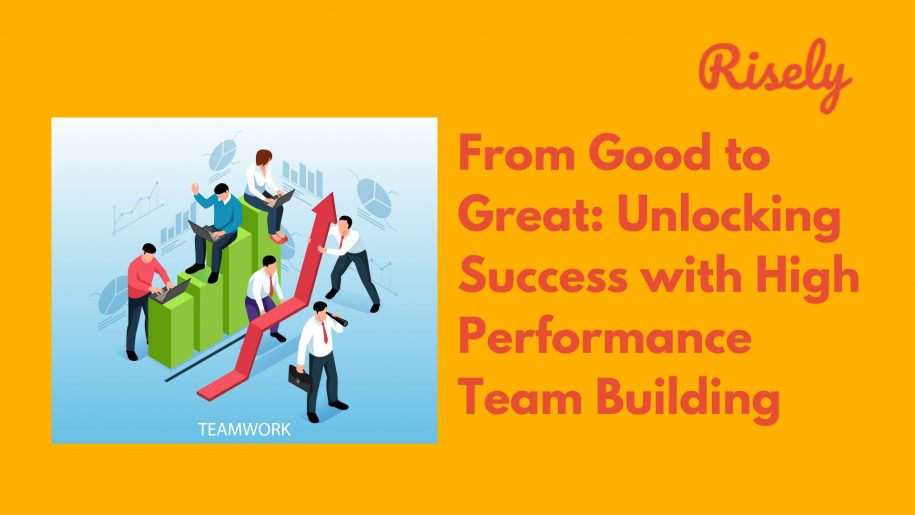From Good to Great: Unlocking Success with High Performance Team Building
Building a team that consistently performs at its best is crucial for success. This blog will explore the fundamental principles, strategies, and exercises that can help you create a high performing team. Whether you’re a team leader, manager, or team member, understanding how to cultivate a culture of collaboration, trust, and excellence is essential. Keep reading as we delve into high performance team building characteristics, the benefits they bring, and practical tips to develop and maintain such teams. Get ready to unlock the full potential of your team and propel it towards greater achievements. Let’s embark on this journey of high-performance team building!What is a high performing team?
A high-performing team is a group of individuals who work together collaboratively to achieve exceptional results and surpass expectations. These teams are characterized by their ability to consistently deliver high-quality work, meet or exceed goals, and continuously improve performance. High-performing teams demonstrate strong communication, trust, and alignment toward a shared vision or objective. They leverage each team member’s unique strengths, promote a culture of accountability and support, and strive for continuous learning and growth. Such teams often exhibit high motivation, productivity, and innovation, leading to outstanding outcomes and success.Characteristics of high performing team
High performance team building requires a deliberate focus on specific characteristics that contribute to their success. Some key characteristics of high performance team building:- Clear goals and shared vision: High-performance teams clearly understand their goals and have a shared vision of what they want to achieve. This helps to align team members and create a sense of purpose and direction.
- Trust and collaboration: Trust is the foundation of effective teamwork. High performance team building fosters an environment of trust where team members feel comfortable expressing their ideas, sharing feedback, and supporting one another. Collaboration is encouraged, and diverse perspectives are valued.
- Effective communication: Effective communication plays a crucial role in high performance team building. They prioritize open and honest communication, ensuring that information is shared transparently and everyone is informed. Active listening and respectful dialogue are encouraged.
- Complementary skills and roles: High performance team building bring together individuals with complementary skills and expertise. Each team member has a defined role that aligns with their strengths, allowing them to contribute their best to the team’s success.
- Continuous learning and improvement: High performance team building have a growth mindset. They embrace a culture of continuous learning, seeking opportunities to develop their skills and knowledge. They learn from both successes and failures, using them as stepping stones for improvement.
- Supportive and positive culture: High-performance teams foster a supportive and positive culture where individuals feel valued and appreciated. Celebrating achievements, recognizing efforts, and providing constructive feedback are standard practices.
Other Interesting Reads
Benefits of high performance team building
High performance team building offers numerous benefits to organizations. Here are some key advantages:- Increased productivity: High-performance teams are known for delivering exceptional results. By optimizing communication, individual strengths, and collaboration these teams are more productive and efficient in achieving their goals.
- Enhanced innovation and creativity: High-performance teams foster an environment encouraging innovation and creativity. When team members feel supported, empowered, and encouraged to share ideas, they are more likely to think outside the box and develop innovative solutions.
- Improved problem-solving: High-performance teams excel at problem-solving and decision-making. They leverage diverse perspectives, collective expertise, and effective communication to address challenges and make informed decisions.
- Greater employee satisfaction and engagement: Being part of a high performance team building can significantly boost employee satisfaction and engagement. When team members feel valued, empowered, and recognized for their contributions, they are more motivated to perform at their best.
- Higher employee retention and loyalty: Managers prioritizing high-performance team building often experience higher employee retention rates. Employees in a high-performing team are more likely to feel connected, engaged, and committed to the team.
- Improved customer satisfaction: High-performance teams are committed to delivering exceptional customer experience—their focus on collaboration, problem-solving, and continuous improvement results in higher customer satisfaction and loyalty.
How to create high performance team?
A high performance team building requires a systematic and intentional approach. Some steps to help you create a high-performance team:- Define clear goals and objectives: Clearly articulate the goals and objectives of the team. Ensure that team members have a shared understanding of what they are working towards. Establish measurable targets to track progress and success.
- Recruit and assemble the right team: Select individuals with the skills, knowledge, and experience required to contribute to the team’s success. Look for diverse perspectives and complementary skill sets that will enhance collaboration and problem-solving.
- Foster a culture of trust and open communication: Create an environment where trust and open communication are valued. Encourage team members to express their ideas, concerns, and feedback without fear of judgment. Build trust through transparency, active listening, and respect.
- Encourage collaboration and teamwork: Foster a collaborative atmosphere where team members work together towards common goals. Promote cross-functional collaboration, encourage knowledge-sharing, and create opportunities for teamwork and cooperation.
- Invest in professional development: Provide opportunities for team members to enhance their skills and knowledge through training and professional development programs. Encourage continuous learning and support team members in achieving their career goals.
- Foster a supportive and positive work culture: Create a work environment that values and supports team members. Recognize and celebrate achievements, provide regular feedback and constructive criticism, and foster a sense of camaraderie and mutual support.
Types of high performance team building
Managers can employ various types of high performance team building activities to foster collaboration, communication, and synergy among team members. Some common types of high performance team building include:- Team building exercises: These are structured activities designed to promote teamwork, trust, and communication within the team. Examples include problem-solving challenges, team-building games, and outdoor activities that require cooperation and collaboration.
- Training and development programs: Providing opportunities for team members to enhance their skills, knowledge, and abilities through training and development programs can contribute to building a high-performance team. These programs can focus on leadership development, communication skills, conflict resolution, and other essential competencies for teamwork.
- Retreats and off-site: Taking the team away from the usual work environment and engaging in focused discussions, brainstorming sessions, and team-building exercises can foster a stronger bond and alignment among team members. Retreats and off-site meetings provide an opportunity to reflect, strategize, and build relationships.
- Continuous feedback and performance management: Establishing a culture of constant feedback and performance management is crucial for building a high-performance team. Regularly evaluating individual and team performance, setting goals, providing constructive feedback, and recognizing achievements help to drive accountability, motivation, and improvement.
- Cross-functional collaboration: Encouraging collaboration and interaction among different departments and functions within the organization can lead to the formation of high-performance teams. Cross-functional projects, task forces, or committees allow team members to work together, leverage diverse expertise, and achieve shared objectives.
- Team-building workshops and seminars: Conducting workshops and seminars focused on team dynamics, communication skills, conflict resolution, and other relevant topics can enhance team-building efforts. These sessions provide a platform for team members to learn and practice essential skills for effective collaboration.
Conclusion
In conclusion, building a high-performance team is not just about assembling a group of individuals but about fostering a culture of collaboration, trust, and continuous improvement. By implementing the strategies and exercises discussed in this blog, you can create a team that consistently exceeds expectations and achieves remarkable results. Remember, high performance is not an overnight achievement but a journey that requires commitment, communication, and a shared vision. Embrace the power of teamwork, empower your team members, and celebrate their accomplishments. Investing in high performance team building is an investment in your team’s long-term success and growth. So, take the first step today and watch as your team transforms into a force to be reckoned with.Test your communication skills now to foster a high performance team building
Get detailed insights delivered straight to your inbox in just a few minutes.
Frequently Asked Questions
What are the 5 important elements for building high-performing teams?
5 important elements for building high-performing teams are clear goals, effective communication, trust and mutual respect, complementary skills and roles, continuous learning, and improvement.
How do you build a high-performance team?
To build a high-performance team, leaders can:
1) Clearly define goals and communicate them to the team.
2) Foster open and effective communication channels.
3) Cultivate a culture of trust and mutual respect.
4) Ensure team members have the necessary skills and provide growth opportunities.
1) Clearly define goals and communicate them to the team.
2) Foster open and effective communication channels.
3) Cultivate a culture of trust and mutual respect.
4) Ensure team members have the necessary skills and provide growth opportunities.
How does team building improve high performance?
Team building improves high performance by fostering stronger relationships among team members, enhancing communication and collaboration, and promoting a positive and supportive team culture.
What are the 3 key elements of high-performing teams?
The three key elements of high-performing teams are:
1) Shared goals
2) Strong communication
3) Trust and collaboration
1) Shared goals
2) Strong communication
3) Trust and collaboration
Other Related Blogs
5 Unique Benefits Of Online Leadership Coaching
5 Unique Benefits Of Online Leadership Coaching Remember the days of leadership development being confined to a stuffy conference room filled with flipcharts and generic advice? Yeah, those days are…
Performance Management Training: Empowering Managers To Manage Better
Performance Management Training: Empowering Managers To Manage Better Remember that feeling of dread when you knew performance review season was rolling around? Yeah, us, too. For many employees, performance reviews…
Manager Development Goals And How To Reach Them: Opportunities And Areas To Focus On
Manager Development Goals And How To Reach Them: Opportunities And Areas To Focus On You’ve meticulously crafted a development program for your high-potential employees, but their managers just aren’t on…
Grooming for Management: The Key to Building a Sustainable Leadership Pipeline
Grooming for Management: The Key to Building a Sustainable Leadership Pipeline Imagine a crucial leadership position opening up in your organization. You scramble to fill the role, internally and externally,…


